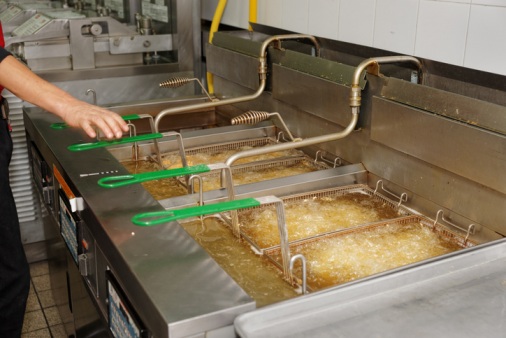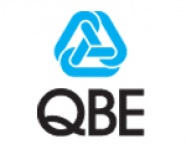The dos and don'ts of industrial fryer safety

By QBE Senior Risk Manager Adrian Simmonds
Several household names in food manufacturing have suffered industrial fires in recent years.
Many processed foods that we buy in the supermarkets will have been deep fried or flash fried in hot oil as part of the preparation, to seal in flavour and give a golden coating. Industrial fryers are widely used in factories to prepare foods such as crisps and snacks, doughnuts, potato products, onion rings, burgers and chicken nuggets.
With frying oils being heated to very high temperatures, often close to 200˚C, there’s an inherent fire risk. Several household names in the food manufacturing sector have suffered fires to their industrial premises in recent years.
To add to this risk, composite insulated sandwich panels with a combustible core may have been used to construct partitions and ceilings around fryers, leading to a significant fire spreading risk. Fire suppression systems are usually installed on industrial fryers, but their reliability and effectiveness can be dependent on human factors.
Risk management processes
As a leading business insurer, we know that having thorough risk management processes in place can help to minimise the risk of fire in commercial and industrial properties. For industrial fryers (not fryers in commercial kitchens) these could include:
- Carry out comprehensive pre-start-up fryer checks and inspections to ensure all process controls and fire systems are in service and operational.
- Have low-level oil and over-temperature switches interlocked to shut down the fryer heating, oil recirculation and extraction, and have daily/weekly test regimes to confirm that the fryer heating cannot be started if the switches are triggered. These should also be backed up by monthly maintenance tests to verify the switches are functioning correctly.
- Ensure non-combustible construction in walls/partitions and ceiling for 6 metres from the fryer, or for 3 metres from the fryer if it is inside a dedicated 1-hour fire resistant enclosure. Carry out monthly testing of fire shutters if installed in a dedicated enclosure.
- Any fire suppression system should be kept permanently in automatic mode and should be interlocked to prevent the fryer heating system operating if the system is in Fault mode or if switched to Manual/Isolate.
- The fire suppression system should be verified on every production shift that it is in automatic mode. Also, weekly inspections to verify the equipment is in good condition, any valves are in the correct position, cylinders are pressurised, tanks are full, and ballcock valves are operational.
- It’s recommended to have quarterly maintenance inspections of the fire suppression system carried out by qualified contractors. And an annual inspection to include full discharge tests of the system.
- Consider having manual activation buttons installed adjacent to the fryer and also away from the fryer to enable manual activation if required.
Emergency response plan
Should the worst happen it’s important that the business has made everyone aware of what to do in the event of a fire.
Emergency response plan: A comprehensive emergency response action plan should be drawn up and posted on the wall close to the fryer and also at a safe distance from the fryer. To include photographs/images of the key components and clear instructions of what should be done by operators and emergency responders in the event of a fire and/or fire suppression system discharge.
Training: All operators and emergency responders should be trained on emergency response procedures and a training needs/training record matrix kept up to date with refresher training dates pre-scheduled.
CCTV: Consider installing Closed Circuit TV to cover the area around the fryer to aid emergency response and monitoring of a fire situation, as well as the status of the fire suppression discharge as it occurs.
Download our free factsheet
To help businesses be more prepared, we’ve produced a free factsheet with information on:
- Emergency response planning
- Fryer controls
- Inspection and maintenance
- Construction and enclosure
- Fire suppression
You can download our Industrial fryer hazard controls guidance here.
Risk management services for QBE customers
QBE helps businesses build resilience through risk management and insurance.
Depending upon the size and complexity of the business needs, QBE customers can access a wide range of risk management services, self-assessment questionnaires and risk management toolkits which are focused on the key causes of claims, and on generating action plans for improved outcomes - including protecting employees, reducing risk and making claims less likely. You can find out more about how QBE helps businesses to manage risk here.
Need to claim? Report it early
Finally, a reminder that if you have an incident and need to make an insurance claim, it’s important that you report it as soon as possible, ideally the same day. Reporting a claim early can save time and help you to receive any claim payments faster, as well as allowing us to help mitigate the cost of third-party claims.
Downloads
About QBE
QBE European Operations is part of QBE Insurance Group, one of the world’s leading international insurers and reinsurers and Standard & Poor’s A+ rated. Listed on the Australian Securities Exchange, QBE’s gross written premium for the year ended 31 December 2018 was US$13.7 billion.
As a business insurance specialist, QBE European Operations offers a range of insurance products from the standard suite of property, casualty and motor to the specialist financial lines, marine and energy. All are tailored to the individual needs of our small, medium and large client base.
We understand the crucial role that effective risk management plays in all organisations and work hard to understand our clients’ businesses so that we offer insurance solutions that meet their needs – from complex programmes to simpler e-trading solutions – and support them in minimising their risk exposures. Our expert risk management and rehabilitation practitioners focus on helping clients improve their risk management so that they may benefit from a reduction in claims frequency and costs.

